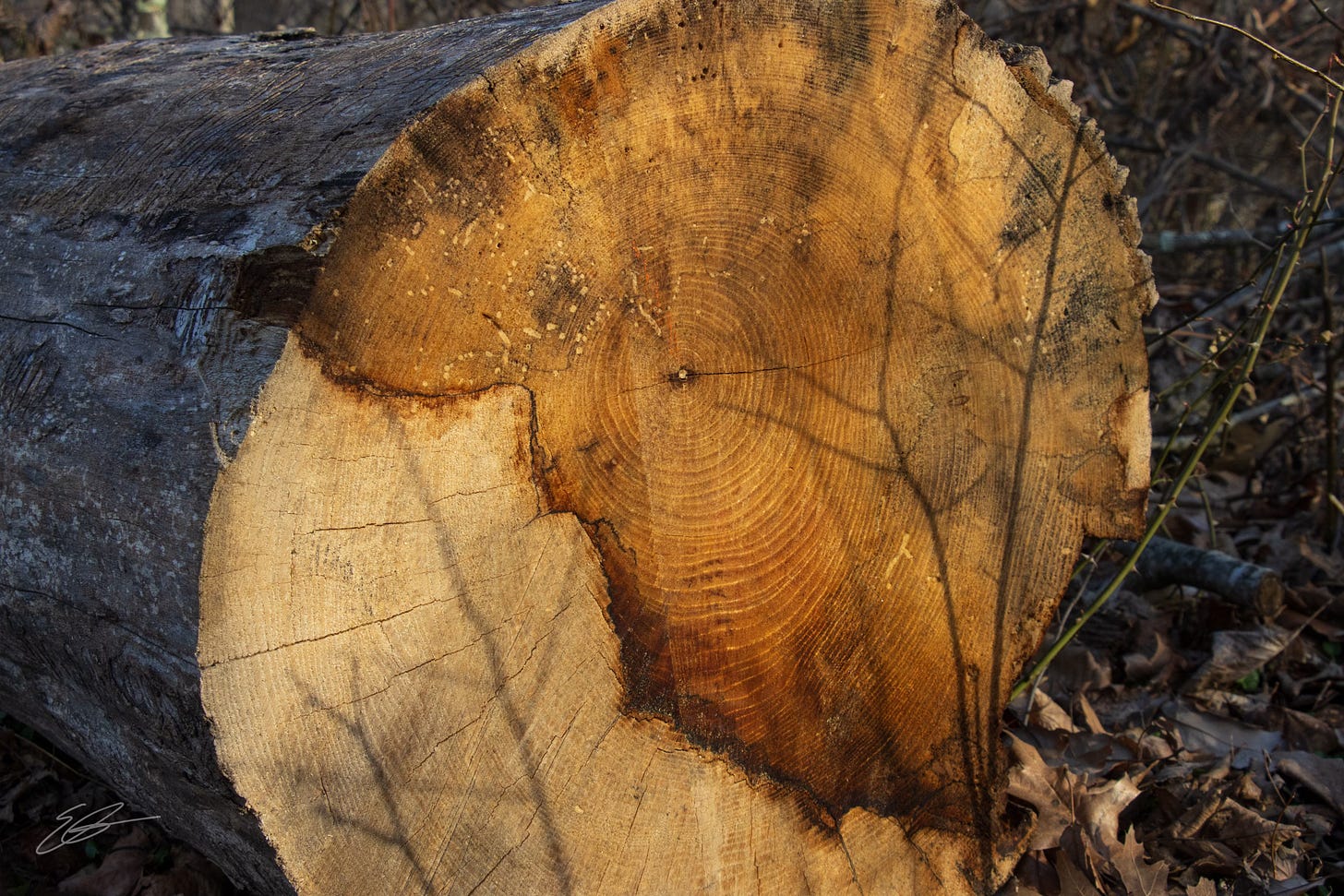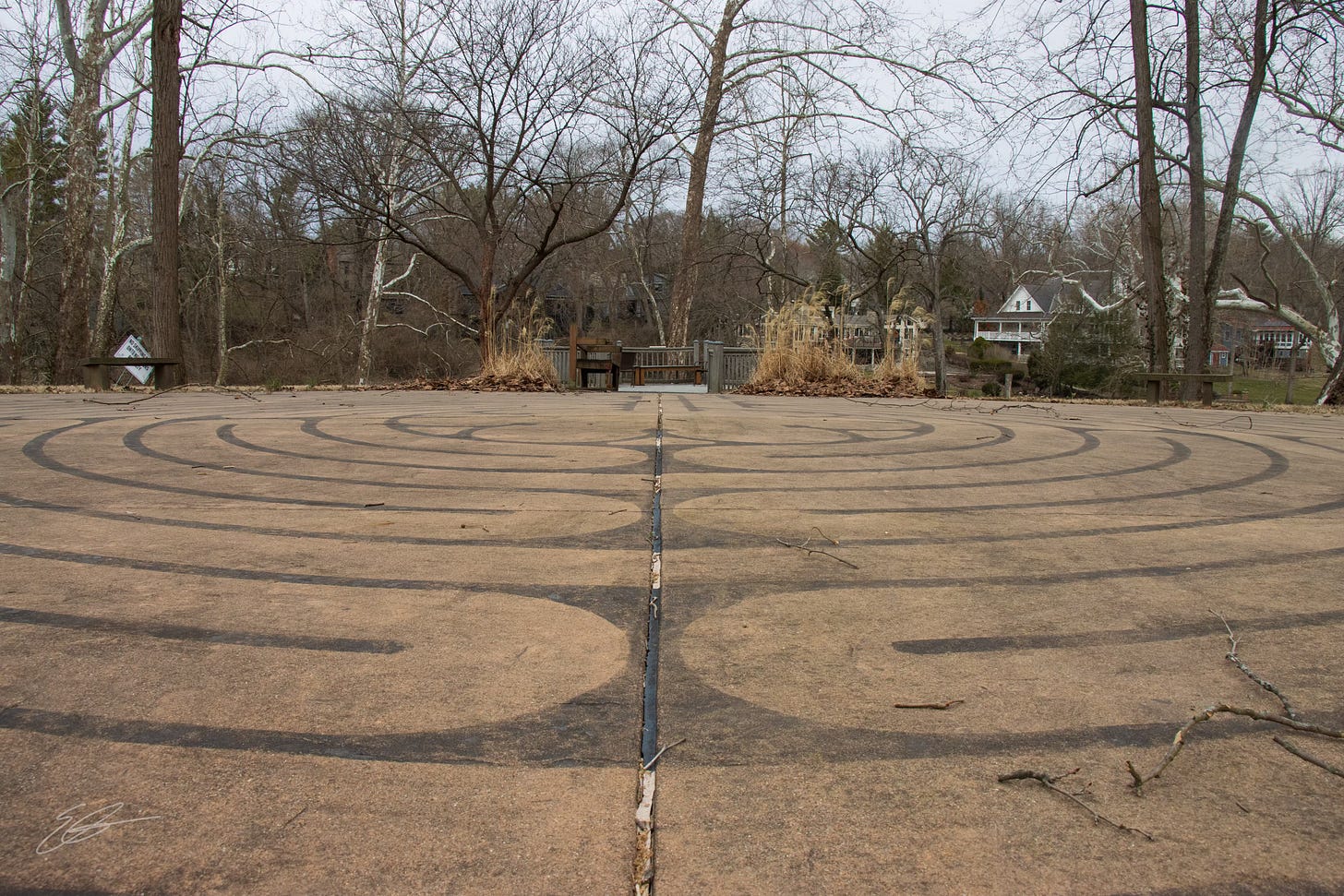Psalm 41 - A Warrior/Knight Labyrinth and a Sage/Gardener Labyrinth
So I saw two labyrinths on Friday morning. One an “official” labyrinth and one that sure looked like one but would be a bit more difficult to walk and pray. Here they both are.
One of them is the end of a large tree that looks like it had recently fallen across a trail and then was cut in pieces to be able to reopen said trail.
The second is at a Jesuit retreat center only about 15 minutes away from that trail.
At the time, I was really wrestling with what I was hearing in Psalm 41. But something came to me on Saturday morning as I was coming towards the end of one of the books I’m currently reading. It is called Sage Warrior by Valarie Kaur. Ms Kaur writes from her perspective as a Sikh and the book is a back and forth between stories of Sikh gurus and a pilgrimage she did with her family to places in those long-ago stories. The crux of the book is that the Sikh gurus lived not just as warriors or sages but they lived as both. At times they leaned warrior because of the circumstances they faced and other times they leaned sage. But both sage and warrior were present throughout.
I was especially drawn to how so many of the teachings of the gurus she shares sound a lot like some of what we read of Jesus in the Gospels and in the practices of Christians through the ages.
One story in particular was of a guru who was calling upon the people to devote their entire selves to the cause and he asked, “Who among you will give your head for the Guru?”1. In the larger context of the story, it sounded a lot like Jesus saying that those who follow him need to be prepared to take up their cross daily and follow and to leave all else behind.
Similarly Kaur shares about an end-of-day practice that sounds a lot like the “Examen” of the Ignatians. The Examen was a practice developed by Ignatius to help people reflect on their day, confess what needed to be confessed, pray for what needed to be prayed, and commit to what new course would be ahead in the following day. Here’s what Kaur shares of her practice which sounds very sage-like.
Every night, when I rest my head on the pillow, the Wise Woman in me says: Think of today as an entire lifetime. What was the most joyful part? What was the hardest part? What are you grateful for in this lifetime? Finally, she asks: Are you ready to let go of this lifetime?2
She continues with this of a moving to beginning anew...
Each night, I practice dying. Each morning, when I wake up, it is a gift. A rebirth. I wake with my children and we say to each other: I get to be alive. I get to be alive today. I get to be alive today with you.3
Sure sounds pretty similar, doesn’t it both of the Ignatian Examen as well as the call of Jesus to “die” in order to be reborn.
This echoes a lot to me of a book I read just before this that was recommended by a 90+ year old member of the congregation I serve. The book is called The Knight and the Gardener: How Worldviews Make Worlds by Cassidy Steele Dale. The book is quite different than Sage Warrior as it is a series of short 4-5 sentence reflections on living as a knight and living as a gardener in the world. Basically, the knight lines up with the warrior and the gardener lines up with the sage. What Dale writes is very similar to Kaur of how we all lean toward one or the other but that both are necessary for living and functioning in the world. The world cannot be all warriors/knights and it cannot be all sages/gardeners. In our most recent church newsletter, I do go into a good bit of depth about the book. Click here to read my article on it.
Going back to the person of Jesus, we see how much of the time Jesus functioned as a sage/gardener but there were times, when needed, that he functioned as a warrior/knight. Like with so much of what I have come to see in life, it isn’t an either/or. It is some form of a both/and.
If you have made it this far, you might be wondering what all this has to do with Psalm 41. Well, there’s a lot of this Psalm that feels like a gardener - calling upon people to consider/care for the poor and calling upon God for graciousness and empathy and compassion. There’s a deep sense of nurture and transformation that comes with sage/gardener.
But the Psalm also has some warrior/knight to it. It recognizes that there are people seeking to actively cause harm and calling upon God for action and protection (and subtext likely meaning that the writer of the Psalm will do the same). There is also a sense of a clear victor and a clear vangquished. Again, warrior/knight.
But again, it isn’t about just one or the other. Warrior/Knight or Sage/Gardener. It is that there are times when warrior/knight is necessary. To use these photos as an example. There needed to be some warrior/knight to remedy the tree that fell across the path. Someone needed to come and use a chainsaw to cut that tree into pieces so that the way could be restored. In doing so, parts of the tree that are normally not seen are now exposed (hence seeing a bit of a labyrinth in the rings of that fallen tree). But it wasn’t done just out of spite or anger but instead out of necessity to restore the path. Warrior/Knight.
But the other labyrinth speaks sage/gardener to me. Unlike the other labyrinths this week, it is completely level. There’s no rocks or stones that divide the paths. It is (relatively) flat. It is beautifully accessible and open to anyone and nothing to trip someone up. When I was first reading the Psalm, I thought of how to “consider the poor” means that we have to be able to see others, not be blocked from view or have anything separating us. To truly consider/care/help, we must be present with. Again...sage/gardener.
I cannot recommend both of these books highly enough. One is shorter (Knight/Gardener) and the other is more engaging (Sage Warrior). One is from a largely-Christian worldview (K/G) and the other from a Sikh worldview (S/W). One is free to download from Dale’s website (LINK) and the other needs to be purchased.
But they beautifully flow together, weaving in and out of similar ideas even though coming from different perspectives. Both spoke deeply to me about reflecting on how I am moving in the world right now (I generally think I’m pretty much sage/gardener most of the time, but right now feeling a lot more warrior/knight) and also in how I see others moving in the world.
And I was deeply moved and challenged by what Kaur shares with her children each morning. How can I say this for myself, to my family and those close to me, to those I like in the world, to those I don’t.
I get to be alive.
I get to be alive today.
I get to be alive today with you.
Psunday Psalm Psummary - Labyrinths
Grace, Peace, Love, and Joy,
Ed
PS - I had to go to an appt on Friday afternoon and Scout decided that I wasn’t allowed to go. I had taken her out to pee before leaving and she laid down in the “grass” and rolled on her back like this.
Kaur, Valarie. Sage Warrior: Wake to Oneness, Practice Pleasure, Choose Courage, Become Victory (The Revolutionary Love Project) (p. 305). (Function). Kindle Edition
Kaur, Valarie. Sage Warrior: Wake to Oneness, Practice Pleasure, Choose Courage, Become Victory (The Revolutionary Love Project) (p. 309). (Function). Kindle Edition.
Kaur, Valarie. Sage Warrior: Wake to Oneness, Practice Pleasure, Choose Courage, Become Victory (The Revolutionary Love Project) (p. 309). (Function). Kindle Edition.










I want to start beginning the day with that refrain too! Thanks, Ed!
Did you see that wonderful video a while back of a child whale frolicking in the sea jumping out and diving in over and over again repeatedly (breeching) after she had been released by humans from a net that was killing her? Thanks and Joy. Now I know God does not expect either thanks or joy. Fine. Just thank yourself with exuberance that you're doing something right and good. https://www.youtube.com/watch?v=tcXU7G6zhjU